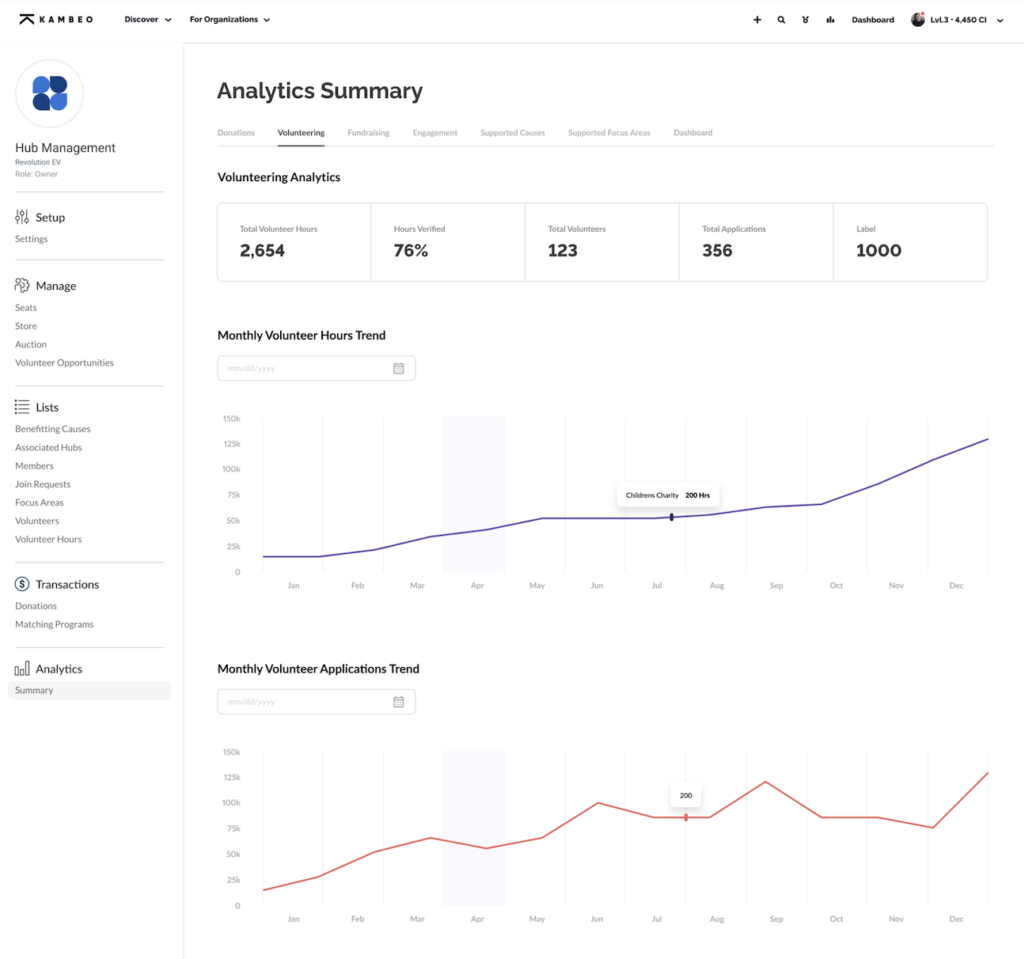We track business expenses with log books, we review employee performance with evaluation checklists, and we monitor deadlines with project management software.
These measurement practices enable organizations to understand their current progress and identify areas of improvement to reach their desired outcome(s).
Employee volunteer programs are no different, as every organization that implements one should be able to gauge how many employees are involved and how much each employee is giving back. By tracking this data, an organization can answer the question, “Is our employee volunteer program effective?”
The purpose of this blog is to explore how your organization can track an employee volunteer program and the primary benefits of monitoring such a key operation of your business.
Old methods of tracking an employee volunteer program
Employees want to be a part of something greater. Aside from being fulfilled with the responsibilities that their 9-5 roles entail, many employees desire to become active community supporters on behalf of their workplace. In fact, 60% of employees said they would volunteer more if it were organized by an employer.
Organizations are helping employees live out this desire by developing an employee volunteer program—one that encourages employees to give back in ways that are meaningful to them.
However, as mentioned above, many organizations don’t have a suitable method for knowing if their employee volunteer program resonates and understanding the impact each employee is making.
Below are a couple of outdated methods that an organization might still be using to track an employee volunteer program:
Excel spreadsheet
To track employee volunteering, a company might often use an Excel spreadsheet. The downside? This information isn’t updated in real time, and the process isn’t automated.
Think of how many steps would need to be taken to update employee volunteer data?
- Employees will email the corresponding contact (likely an administrator of the volunteer program) with the number of volunteer hours they completed, the name of the charity or nonprofit they volunteered with, the date of their volunteer day etc…The admin will log the respective information from that email into an Excel spreadsheet.
- If the admin wants to look at any patterns or trends in the data, they will have to search for the appropriate graph in Excel.
- This process will be repeated every time an employee volunteers.
As an admin will have to absorb an abundance of information and do so promptly, the volunteer data may not always be entered into Excel with 100% accuracy.
No measurement
As many organizations don’t know what metrics to track, nor do they truly understand the full value behind tracking these metrics, a common approach is not to measure employee volunteering at all.
Some organizations will have a volunteer program in place, offering employees a set amount of paid volunteer days, and will even go as far as to encourage their employees to take advantage of these volunteer days. However, no further steps are taken after an employee becomes involved in a volunteer opportunity.
Educated guesses can be made on how well an organization thinks an employee volunteer program is performing; however, this guesswork doesn’t translate into valuable insights or lead to informed decisions.
Tracking employee volunteering with a social impact platform
Take the time to look at the trends in your data, not input your data. A social impact platform does just this—automatically inputting your employees’ volunteer hours into the back end every time a volunteer opportunity is completed. Minimal grunt work means more time for your organization to analyze the data.
A social impact platform tracks the below for you:
- Number of employees who have volunteered.
- Total volunteer hours accumulated.
- The volume of volunteer hours month over month.
- Number of causes (charities and nonprofits) supported through volunteering.
Benefits of tracking an employee volunteer program
1. Gauge employee involvement
To effectively understand if your employee volunteer program is resonating with your staff, you need to analyze the data and draw conclusions from it.
For instance, suppose you issue 4-paid volunteer days a year (one per quarter) and have a company size of 160 employees. After tracking the data using a social impact platform, these are your findings after one year:
- 123 employees have volunteered (76.8% of employees are volunteering).
- 2,654 total volunteer hours accumulated.
- 160% increase in monthly volunteer hours (from Jan 2022–Dec 2022).
- 86 causes supported through volunteering.

Based on the data above, you can confidently conclude that your volunteer program is something that resonates with your employees.
2. Stay updated frequently
Rather than updating an Excel document monthly when an admin has the time in their busy day, the data on a social impact platform is updated in real time and done so automatically.
There shouldn’t be a designated day per month when data is “ready” to be analyzed. A social impact platform allows your organization to look at data anytime during the month. Stay updated frequently on how many employees are involved in your volunteer program, how much time they are donating back into the community, and how many causes are being supported.

3. Enhanced social sharing
Posting first-party data on your owned media channels offers an opportunity to strengthen relationships with your clients (in this case, your followers). As your employee volunteer data is directly collected and managed within your organization, it is transparent and credible to share.
There is never a right or wrong time to tell the world the progress you are making and how your employees are helping contribute to social change in an impactful way—with real-time data coming straight from the source.
4. Ability to measure retention
Organizations aren’t just implementing an employee volunteer program to look good on paper. A PWC study revealed that employees committed to their organizations are 87% less likely to resign. In order for employees to stay committed to their jobs, they must be engaged—having a clear understanding of how they contribute to a company’s purpose. An employee volunteer program is the solution, allowing employees to find personal causes to support while helping contribute to their company’s shared purpose of enacting social change.
On top of starting an employee volunteer program, analyzing the data from the program helps you track how many employees you have retained as a result of the program.
In the below scenario, let’s assume you have a company size of 750 employees and notice the following after tracking your employee volunteer program year-over-year:
Year 1: 76% employee volunteer participation rate. 87% retention rate.
Year 2: 90% employee volunteer participation rate. 90% retention rate.
The above scenario shows the correlation between volunteering and retention. The more employees involved in your volunteer program, the higher the retention rate.
Track Employee Volunteering With A Social Impact Platform
A social impact platform does the heavy lifting for you—tracking key data as your employee volunteer program becomes more widely adopted. All that’s left for your organization to do is analyze the data provided to answer this question, “How effective is our employee volunteer program?” The answer is in the numbers.



